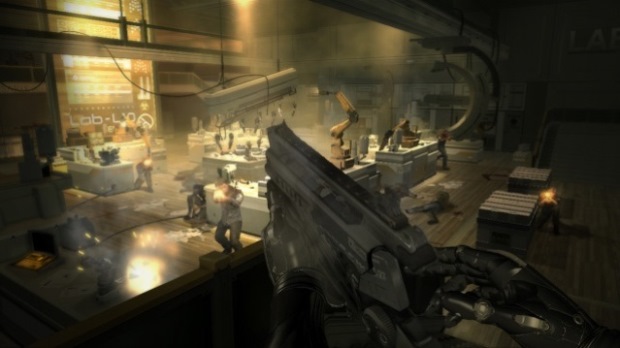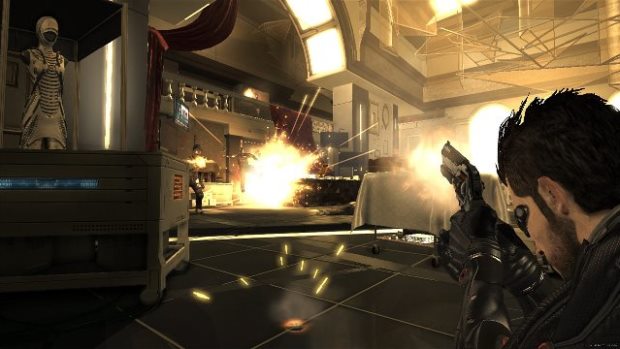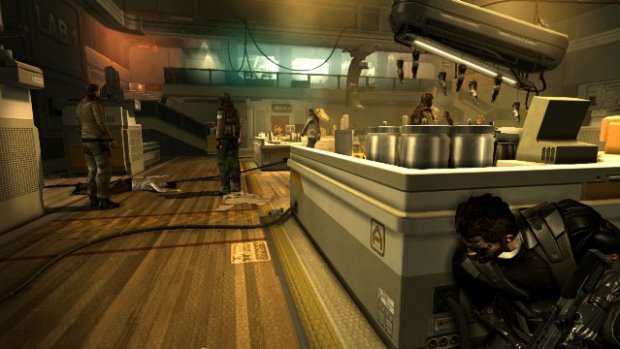Deus Ex: Human Revolution – Director’s Cut Review
How do you make a former Game of the Year winner even better? That’s the question Eidos Montreal asked themselves when they decided to bring sci-fi masterpiece Deus Ex: Human Revolution to Nintendo’s Wii U. The question wasn’t just how to port it, but how to improve on it, how to build upon it. The answer, of course, was “Listen”. Listen to the fans, listen to the gamers, the communities, the internet massive, take on board their concerns and perceived shortcomings and iron them out, once and for all. Despite the decision to take the Director’s Cut edition multi-platform, Eidos Montreal have largely succeeded in fixing everything that was wrong with Human Revolution in the first place – which wasn’t a lot, to be fair.
Set in a mildly dystopian future, Eidos Montreal’s prequel tells the story of Adam Jensen, a security consultant rebuilt with DNA-based cybernetics after a terrorist attack left him at Death’s door. Caught up in a brewing street war between human purists dead set again cybernetic enhancement and the corporations that propagate it (such as Sarif Industries, who Jensen works for), he finds himself tasked with taking down a global terrorist network, all while struggling to reconcile his former life and humanity with the barely-human machine he has been forced to become. The conflict on the global stage is as fierce as the war in the heart of Detroit, as the wealthy pay for augmentations to improve their quality of life whether they need to or not, some stacking up the cybernetics so high that they’re barely classed as human any more. Jensen isn’t given a choice – but his enhancements are significant and altogether game-changing.

Upon its initial release, Human Revolution was a certified hit. Incredibly well written and acted, the story is compelling, intriguing and, occasionally, scarily plausible. Eidos successfully sculpted a world of dark alleys and neon lights, all draped in a beautiful, burnished gold sheen that elevates common graphics to bona fide art. The only substantial complaint anyone could find to level against Human Revolution involved the boss fights.
Built on a foundation of player choice, Human Revolution allows you to play the game the way you want to, following one of the three gameplay “pillars” of Stealth, Combat and Social skills. You can run through the whole game as a straightforward shooter, if you choose to – or the entire game can be played without tripping a single alarm or firing a single bullet. Only the boss fights break this tenet, as they force you into direct, violent confrontation in such a way that goes savagely against Deus Ex’s ethos of choice.
Naturally, these encounters present one of biggest changes to the Director’s Cut. Now redesigned to allow for a more tactical approach, each one can be beaten without violence. Eidos have done this cleverly, allowing you to adhere to the previous gung-ho method or utilise Jensen’s other skills – notably Hacking – to manipulate the environment and avoid balls-out violence. The change isn’t immense (in fact, if you hadn’t played it before, you probably wouldn’t notice); it’s subtle, and simply serves to bring the previously incongruous boss fights in-line with the rest of the experience.

The Wii U version has a lot of bells and whistles added on thanks to the GamePad, and the PS3 and 360 versions borrow some elements for use with either the Vita or a smartphone / tablet via Smartglass, respectively. On the 360 the uses of Smartglass are minimal, but pretty cool nonetheless, allowing you to use your phone or tablet to perform the Hacking minigame or manage your skills and inventory. It’s very cool, and certainly feels very “digital age”, but it’s not much quicker or easier than using the controller. There’s also an element of disconnection when you put the controller down to use a different device, which isn’t there with the Wii U version.
But then, Deus Ex is a game that doesn’t really need such gimmickry. It’s fun, yes, and a nice use of the technology, but the core game is compelling and immersive enough without it. The graphical improvements, on the other hand, are very welcome. Deus Ex was good looking enough in 2011, but the golden overlay did play hell with the lighting effects and the anti-aliasing. This has been tweaked and enhanced, meaning that the world looks glossier than ever and the character models look extraordinary.
While enemy AI has been improved during combat, the same problems persist out in the world. Human Revolution never had the most realistic crowd behaviours, and little has changed. In one early mission, I took the same familiar route into the police station via the air ducts, and was still able to emerge into an office and stroll out the door without the officers present so much as questioning my attire. There aren’t many police forces that will ignore the presence of a six-foot, trenchcoat-wearing cyborg, but Detroit’s is apparently one of them. It’s not game-breaking stuff, but the iffy AI at times comes close to undermining everything else that Human Revolution does so well.

As for the combat itself, it’s hard to feel the real difference between this version and the original – though that’s not necessarily a bad thing. It’s still slick, with a cover mechanic so comfortable and intuitive that it’s wonder it hasn’t been emulated twenty times over by now. Melee takedowns, lethal or not, are still satisfyingly tactile and the gunplay is sublime. A New Game+ Mode has been added, so you can begin a new game with an augmented Jensen and max out your skills while facing tougher challenges. Previously the distribution of Piraxis Points (Jensen’s upgrade currency) was such that by the end of the game you could only have realistically maximised a certain number of skills, meaning you had to be thrifty with your choices. You were unlikely to be able to get the most out of either gameplay pillar without sacrificing something from the others. It was a great system, and the New Game+ almost feels like a reward, as you can now continue to improve Jensen to the level of olfactory badass.
The run-time is slightly longer, too, as Eidos have seamlessly integrated the Tong’s Rescue and Missing Link DLC missions into the main game. Both add a few hours of play each and, alongside all the extra weaponry and gear released as pre-order incentives and special edition bonuses, add a decent amount of content to an already impressive package.
VERDICT: The original release of Human Revolution had very little wrong with it. Uneven AI and invasive boss fights notwithstanding, the story, combat, art-style and overall execution was close to faultless. The Director’s Cut repairs every weak link except the AI, which in itself isn’t quite enough to drag the experience down. Improved boss fights, better graphics and the option to enhance your own experience with a dual screen functionality add a sheen of gloss to Human Revolution that you never knew it needed, making this the definitive edition of one of the best games of 2011, and indeed this console generation. Absolutely essential.

INCREDIBLE. This is the pinnacle of our scoring spectrum, reserved for games that truly affect us, that capture our imagination so completely that they affect the standard by which we measure future games. 10/10 is not a declaration of perfection, but an assurance that the game in question is of amazingly high quality and has exceeded our expectations.




